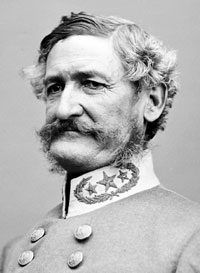Henry Hopkins Sibley (1816-1886)
Henry Hopkins Sibley (1816-1886), the son of Samuel Hopkins and Margaret I. (McDonald) Sibley, was born at Natchitoches, Louisiana, on May 25, 1816. He was the grandson of the influential Dr. John Sibley. When Sibley was seven his father died, and the boy was taken by his mother to live with on uncle in St. Charles, Missouri.
 He attended the Grammar School of Miami University at Oxford, Ohio, then moved to Louisiana to live with his grandfather, who became the boy's legal guardian and obtained his appointment to the United States Military Academy. Although set back one year, Sibley graduated from West Point in 1838.
He attended the Grammar School of Miami University at Oxford, Ohio, then moved to Louisiana to live with his grandfather, who became the boy's legal guardian and obtained his appointment to the United States Military Academy. Although set back one year, Sibley graduated from West Point in 1838.
With a second lieutenant's commission in the Second Dragoons, Sibley saw action in the Second Seminole War. While on leave he married Charlotte Kendall at Governor's Island, New York, in 1840; they had two children. In 1847 he was promoted to captain and given command of Company I of the Second Dragoons.
In the Mexican War Sibley was brevetted a major for bravery at Medellín, near Veracruz, and fought at Cerro Gordo, Contreras, Churubusco, and Molino del Rey. In Mexico he became snow-blind while attempting an ascent of Mount Popocatépetl.
From 1850 to 1854 Sibley and his company were stationed on the Texas frontier—at Fort Graham, Fort Croghan, Phantom Hill on the Clear Fork of the Brazos, and at Fort Belknap, where he conceived the idea of the Sibley Tent after visiting a Comanche village. The Sibley tent, derived from a Comanche style, was conical, with a center pole affixed to a tripod at the bottom. Within it a fire could be lit, and smoke would escape through a hole in the top. The tent was spacious and comfortable in cold weather.
Sibley and his company were stationed in Kansas helping to quell the violence over the slavery question, and in 1857 they marched through the winter to join the Mormon Expedition at Fort Bridler. In Utah Sibley was court-martialed as a result of a feud with his regimental commander, Philip St. George Cooke.
He was afterward sent to New Mexico Territory, and the Second Dragoons were in the unsuccessful Navajo Campaign of 1860. He was later stationed at Fernando de Taos and at Fort Union, where he resigned from the army.
He went to Richmond, Virginia, and there persuaded Jefferson Davis to adopt a grandiose plan to seize not only New Mexico but also Colorado and California for the Confederacy. Commissioned a brigadier general, Sibley went to San Antonio, where he helped organize three regiments of Texans into Sibley's Brigade. He then launched an invasion of New Mexico, marched his army across West Texas to Fort Bliss, and defeated the federals under Col. Edward R. S. Canby near Fort Craig in the bloody battle of Valverde on February 21, 1862. Moving up the Rio Grande the "Army of New Mexico" seized Albuquerque and Santa Fe and moved on Fort Union. High in the Sangre de Cristo Mountains at Glorieta Pass, Sibley's Texans beat a federal force of Colorado "Pikes Peakers" on March 28, 1862, but lost their entire supply train to a raiding party. Forced to evacuate the territory, Sibley began a disastrous retreat through the mountains. He reached San Antonio in the summer of 1862, having lost a third of his men in New Mexico.
Sibley was summoned to Richmond to answer charges filed against him as a result of his poor leadership during the New Mexico campaign. He assumed command of his brigade again in Louisiana in 1863. His diminishing leadership and heavy drinking became especially evident during the battle of Bisland, and he was ordered court-martialed by Gen. Richard Taylor. Although acquitted, he was removed from command.
After the war Sibley went to New Orleans, Richmond, and New York, where he was recruited into the Egyptian army as a general in 1869. In Egypt he was placed in charge of the construction of coastal fortifications, but because of his growing alcoholism and incompetence, he was dismissed by the khedive in 1873.
Sibley spent the last years of his life in poverty at Fredericksburg, Virginia, where he lived with his daughter. There he wrote magazine articles, taught French, worked on several military inventions, and continued his legal efforts to obtain royalties on the Sibley Tent.
He died on August 23, 1886, and was buried in the Fredericksburg City Cemetery.
 He attended the Grammar School of Miami University at Oxford, Ohio, then moved to Louisiana to live with his grandfather, who became the boy's legal guardian and obtained his appointment to the United States Military Academy. Although set back one year, Sibley graduated from West Point in 1838.
He attended the Grammar School of Miami University at Oxford, Ohio, then moved to Louisiana to live with his grandfather, who became the boy's legal guardian and obtained his appointment to the United States Military Academy. Although set back one year, Sibley graduated from West Point in 1838.